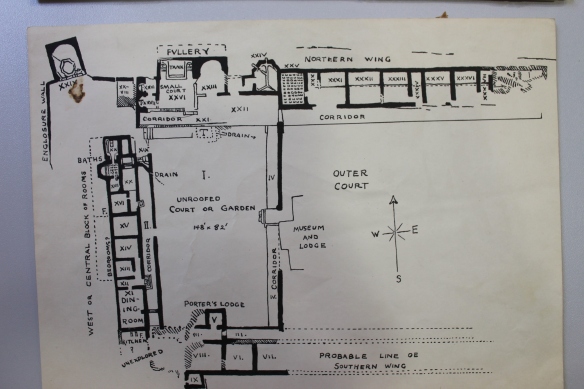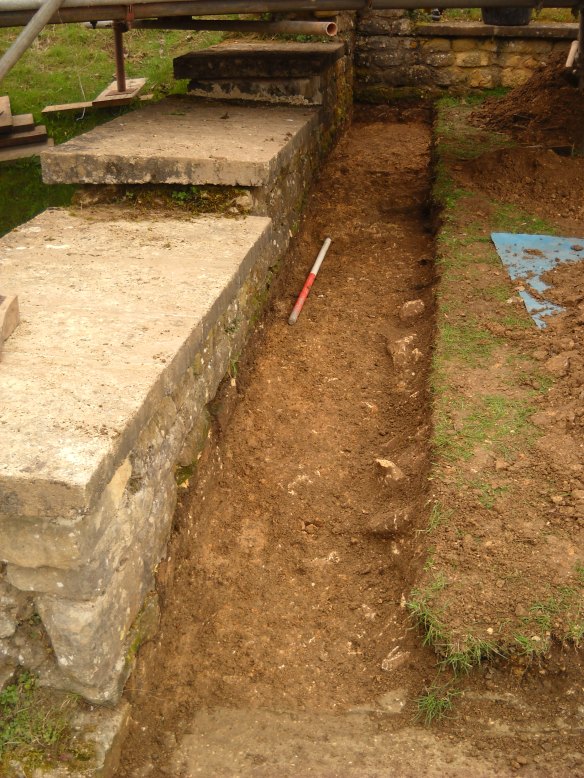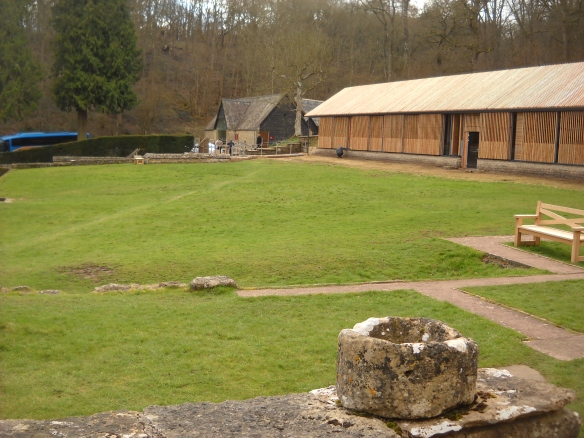Chedworth Roman Villa is a great place to visit. It was built beside a spring at the head of a narrow valley with views out over the landscape, the building arranged around two courtyards.
It was first built about 1800 years ago but was a ruin 300 years later. Picked over for anything useful by the local farmers and then left and forgotten until rediscovered in the 1860s. James Farrer excavated it in 1864 (150 year anniversary celebrations at the villa this year). At that time, the surviving villa walls were built up, consolidated and displayed with some of the finest mosaics left open and protected under wooden cover buildings.
The Villa was at its architectural peak in the late 4th century. The best rooms were in the north and west ranges. Two suites of rooms each with their own set of baths beside the site of the fresh water spring where a sacred building was constructed known as a Nymphaeum. These luxurious ranges of rooms faced south and east and caught the best of the sunlight. High status visitors to the mansion would approach up the valley, perhaps through a gardened and designed landscape (see English Landscape Gardens and Roman Chedworth). They would walk through the inner courtyard and enter the centre of the West Range or perhaps turn right and walk into a large reception hall decorated with a mosaic with an intricate red and white design.
What about the rest? Was there a service entrance? We found this in 2011 when the new West Range cover building was being constructed.

Plan for a 1940s guide book for Chedworth villa. Top is the north range and left the west range. Here were two suites of sumptuous bathing, dining and accommodation rooms linked by corridors. The little understood service range is at the bottom of the picture. Bottom left is marked ‘unexplored’ and excavations here in the 1950s interpreted this area as a large kitchen.The little square room projecting from the bottom edge of the picture was the villa latrine. Top left is the ‘Nymphaeum building around the villa sacred spring. The water flowed through the north and west range sets of baths south through drains across the courtyard to the south range to clean the latrines.
A pre-1950s guide map shows the areas where James Farrer didn’t excavate. One of these was in the south-west corner. The south range is poorly understood. It is set lower down the valley slope and doesn’t get the best sunlight. It seems to be where the service buildings were. Perhaps places where the servants hung out.. containing storage rooms and rooms for food preparation and administration.
In 1954 Eve Rutter from Oxford University, excavated a small square room that projected south of this range. It turned out to be a latrine. Drains leading from the spring would have run through the baths and the dirty water went through drains across the courtyard and sluiced out the loos down slope. All very practical and sensible. A couple of years later Sir Ian Richmond found a wall footing opposite the latrine and demonstrated that there was a short corridor there. The area immediately north of this was thought to be a large kitchen.

During the building of the west range cover building in 2011 archaeological recording was needed when new paths and service trenches were excavated.
In 2011, the West Range cover building work needed new access paths and service trenches and I needed to come to Chedworth whenever new excavations were needed. Cotswold Archaeology had carried out some initial evaluation trenches and these had raised a question about the floor level of the Roman kitchen.

The view from the scaffolding on the West range looking south-east across the access path. The footings of the square building middle left mark the position of the Roman latrine
The South Range as far, as we know it, has a series of rooms stepping down the slope of the valley to the east. At the west end, Meirion’s 1m square evaluation trench had found a level mortar floor but this was above the level of the modern access path. So Simon and I were asked to dig a slot along the south wall of the kitchen so that the architect was able to know the right levels to display floors and create paths.

trench along the south-west side of the kitchen was to understand the Roman floor level. In the south-west corner the cement floor is well preserved but it has been cut away when the villa was demolished and the ground slopes down to visitor access path from where the photo was taken.
Our trench found Victorian pottery from the 1864 excavation mixed with some Roman rubble. We found that the Roman kitchen floor had been dug away on its east side during the villa’s demolition, exposing mortared rubble make-up for the lost floor.

Areas of Roman demolition rubble were found above the old ground service and large fragments of meat bones and Roman tile were found including Aimee’s chunk of flue tile.
A couple of months later, the new access path was being laid further east so I came to take out the material affected by the path. This followed the old line from the visitor reception beside the latrine north towards the West Range.
I came across a strip of unexcavated Roman rubble. No Victorian pot this time but large chunks of Roman tile, oyster shells and meat bones. Below this were flat slates of stone which had settled onto a level graveled surface and this sloped gently upwards towards the West Range. Always a great feeling in archaeological terms when you are troweling and the lumpy rubble peels onto a surface and it’s in the thin band of buried soil trampled into the surface where the finds are made. These date the last footfall along the path or across the floor. Crushed fragments of black Roman pottery on this occasion.

The rubble peeled off onto an inclined plane marking the position of the path from the back door into the service range, latrine and kitchen.
So the kitchen was half the size we had thought it was and on its east side was a path that led up into the service range beside the latrine. It’s the way all the visitors come into the Villa today. We all come in through the service entrance, the back door. Sorry about that, Lord Eldon built his Victorian lodge and museum across the Roman posh way in.



Pingback: The Back Door: Chedworth Roman Villa | Classics...